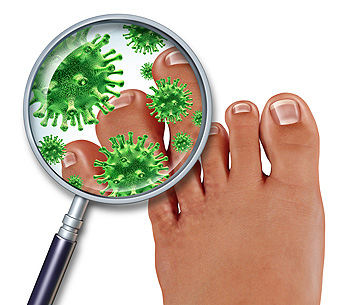 The medical condition that is referred to as athlete’s foot will typically affect many different types of people regardless if they are athletes. The tinea fungus is responsible for this uncomfortable ailment and will survive in moist and warm areas. It is known to be extremely contagious, and it often lives in public pools, showers, and surrounding areas. The noticeable symptoms may include cracked and peeling skin between the toes, dry or raw skin on your feet, or an itchy sensation that may affect the entire foot. There may be pre-existing medical conditions that may include diabetes or a weakened immune system, which can contribute to the onset of athlete’s foot. If you feel you may have developed this ailment, it is suggested to seek the counsel of a podiatrist who can perform a proper diagnosis and correct treatment.
The medical condition that is referred to as athlete’s foot will typically affect many different types of people regardless if they are athletes. The tinea fungus is responsible for this uncomfortable ailment and will survive in moist and warm areas. It is known to be extremely contagious, and it often lives in public pools, showers, and surrounding areas. The noticeable symptoms may include cracked and peeling skin between the toes, dry or raw skin on your feet, or an itchy sensation that may affect the entire foot. There may be pre-existing medical conditions that may include diabetes or a weakened immune system, which can contribute to the onset of athlete’s foot. If you feel you may have developed this ailment, it is suggested to seek the counsel of a podiatrist who can perform a proper diagnosis and correct treatment.
Athlete’s Foot
Athlete’s foot is often an uncomfortable condition to experience. Thankfully, podiatrists specialize in treating athlete’s foot and offer the best treatment options. If you have any questions about athlete’s foot, consult with Dr. Barbara Kilkenny from Barbara A. Kilkenny, DPM. Our doctor will assess your condition and provide you with quality treatment.
What Is Athlete’s Foot?
Tinea pedis, more commonly known as athlete’s foot, is a non-serious and common fungal infection of the foot. Athlete’s foot is contagious and can be contracted by touching someone who has it or infected surfaces. The most common places contaminated by it are public showers, locker rooms, and swimming pools. Once contracted, it grows on feet that are left inside moist, dark, and warm shoes and socks.
Prevention
The most effective ways to prevent athlete’s foot include:
Symptoms
Athlete’s foot initially occurs as a rash between the toes. However, if left undiagnosed, it can spread to the sides and bottom of the feet, toenails, and if touched by hand, the hands themselves. Symptoms include:
Diagnosis and Treatment
Diagnosis is quick and easy. Skin samples will be taken and either viewed under a microscope or sent to a lab for testing. Sometimes, a podiatrist can diagnose it based on simply looking at it. Once confirmed, treatment options include oral and topical antifungal medications.
If you have any questions, please feel free to contact our office located in Southbury, CT. We offer the newest diagnostic and treatment technologies for all your foot care needs.
Read more about How to Deal with Athlete's Foot